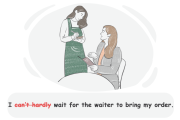What Is a Double Negative?
When two negative markers or two negative structures are used in the same clause, a double negative is formed. Sentences with double negatives are not grammatically correct.
What Are Negative Markers?
Here is a list of common words that negate a sentence:
Common Negative Pronouns
Negative pronouns indicate the absence of people or things. When these pronouns are used in a clause, the verb remains affirmative and no negative adverb can be used. Here are some of the most common negative pronouns:
Common Negative Adverbs
Negative adverbs negate the whole clause and the verbs that follows them most be affirmative.
"Not" is one of the most commonly used negative adverbs that comes after auxiliary and modal verbs to negate the sentence.
not
never
barely
scarcely
hardly


Common Negative Determiners
Negative determiners come before nouns to negate them. Like the other negative markers, they cannot be used with another negative structure, for example a negative verb or adverb, in the same clause.
no
neither
none of
Double Negation
If two negative words, for example a negative noun or pronoun and a negative verb are used in the same clause, a double negative is formed, which is not grammatically acceptable. Look at the examples:
I don't want nothing from you!
The correct sentence would be 'I want nothing from you,' or 'I don't want anything from you.'
I can't hardly wait for the waiter to bring my order.
The correct sentence would be 'I can hardly wait for the waiter to bring my order.'
Spoken English
In some dialects of English, you might hear double or even triple negatives. Remember that they are not considered acceptable in standard English speech or writing.
We couldn't never work with nobody like that.
He never says nothing interesting to no one.
What is Not a double Negative?
In some cases, "not" can be used with a negative adjective or adverb. In such cases, although the adjective or adverb is semantically negative, it does not have a grammatical negative marker; rather, it is morphologically negative. As a result, the result is not a double negative and is grammatically acceptable.
It's not uncommon to see deer in this area.
He was not unhappy with the results.
This sentence basically means "he was happy" but the use of this structure conveys a weaker sense that the adjective "happy".
When is a Double Negative Acceptable?
A special case where two negative structures are allowed in the same sentence can be seen in the following examples where a negative auxiliary or modal verb is followed by the adverb "not" and the main verb. These emphatic double negatives are grammatically acceptable.
I can't just not think about it.
I won't not try this time.
Review
English grammar does not allow use of two negative markers in the same sentence. Common negative markers are
Negative Pronouns | Nobody | Nothing | No one | None | Nowhere |
|---|
Negative Adverbs | Not | Never | Hardly | Barely |
|---|
Negative Determienrs | No | None of | Neither |
|---|
Quiz:
Which of the following sentences contains a double negative?
I can't hardly wait for the weekend.
I don't want anything from you.
She can't find someone to help her.
He doesn't like to go out on weekends.
Which sentence is grammatically correct and does not contain a double negative?
It wasn't nothing to worry about.
They didn't never understand.
He's not unhappy with the decision.
She can't do nothing right.
Sort the following words to create a grammatically correct sentence without any double negatives.
Fill the blanks to form negative sentences, avoiding double negatives. (There are two extra options.)
He didn't see
in the crowded room.
They could
hear the speaker because of the loud noise.
We found
that matched the description in the report.
She has
been to Paris.
It
unexpected to see him there.
Correct each sentence by resolving the double negative.
I don't need nothing from you. → I
from you.
I can't hardly wait for the concert. → I
for the concert.
He never says nothing interesting. → He
interesting.
Nobody wasn't there to help me. →
there to help me.
Comments
(0)
